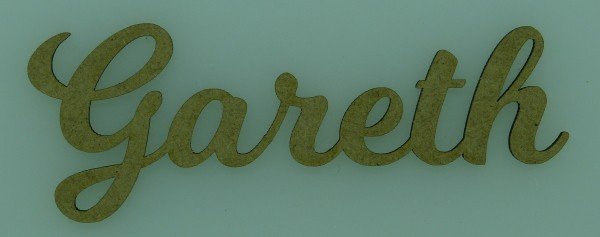These are the materials that you are most likely to use on a daily basis depending on your business or hobby requirements. It is worth putting in the time and effort upfront to understand how these materials interact with the CO2 laser beam. Determine the best settings and keep a record for future jobs. It will save a lot of time and can act as an early indicator of dirty mirrors/lens reducing your power output. It is advised that you use effective fume extraction when cutting any materials with your CO2 laser cutter.
Wood
All woods will cut with a laser, the depth and speed of cut will vary on the density of the wood. Softwoods such as Balsa will cut easier than hardwoods such as Walnut. Take care with woods that contain a lot of resin as there is a higher possibility to get flare-ups (catch fire). As woods are natural materials, there will be a lot of variability in the finish achieved. This is particularly true when engraving as there will be bands of different density wood which will react slightly differently to the laser, giving variable finishes. Other woods to consider are Cherry, Oak, Spruce, Bamboo and Pine.
Plywood
Plywood is more difficult to cut than natural wood due to the adhesives used to hold the individual layers together. There is also a chance of formaldehyde being given off as the laser beam reacts with these adhesives. So good ventilation is a must. As the top surface of Plywood is a natural material, you will get the same issues engraving as you do with solid wood. Plywood also tends to bow if not stored correctly making it very difficult to process unless you are able to keep it flat under the laser head.
MDF & HDF
MDF / HDF are engineered wood products that are held together by adhesives. They has the same issue as plywood with the potential for formaldehyde gas to be formed. However, there are now some “laser friendly” low formaldehyde mix MDF/HDF sheets on the market. Engraving is easier on MDF/HDF as they have a more consistent surface, although the results can be quite bland. You can also get MDF veneers that offer the benefit of a consistent cutting performance, with the beauty of a finished surface.

Paper
Paper cuts easily and quickly with a laser, but you need to make sure there is not too much power as it will burn the edges. If you are doing a mixture of long cuts and fine detail work, it is best to group each type of work and give them different settings. The fine detail work will tend to run slower and will need a lower power setting than the long cuts.
Cardboard
Standard cardboard cuts the same as paper, with just a higher power setting to allow for the increased thickness. Corrugated cardboard is more difficult as it tends to be relatively thick in comparison to standard cardboard. It also has air gaps that collect smoke during the cutting process. This smoke diffuses the laser beam, making it less effective. The usual response is to either increase the power or slow the speed. Both can result in the cardboard catching fire. One solution, if available on your laser software, is to use the Dot function. This pulses the laser, reducing the amount of heat generated within the cardboard.
Cork
Cork cuts and engraves well in most cases, but there can be difficulties in cutting thicker pieces. It may be worth trying out the Dot Mode if you are having difficulties.
Leather and Suede
Leather and Suede both cut easily and can be engraved with reasonable success, just take care that debris does not fall back onto the engraved surface as it is difficult to clean afterwards. The main drawback, however, is the smell, it is extremely pungent (think of burning flesh) and should only be carried out with suitable extraction in place.
Fabrics
Natural fabrics such as Cotton, Denim, Felt, Linen, Silk and Chiffon all cut well and at high speed. Although it is possible to engrave fabrics, they tend to disintegrate if stretched due to the fibres being damaged. Take care with any fabrics that have plastic coatings.
Food Products
It is possible to cut and engrave many food products, but unless you are using a dedicated laser with hygienic surfaces it’s best the food is used for display purposes rather than consumption.
